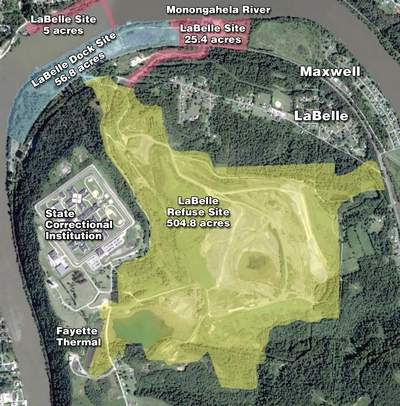Our Toxic Prison - Who is to Blame?
- Jordan Malloy
- Mar 14, 2016
- 4 min read

Photo courtesy of the Abolitionist Law Center.
In a small town in Fayette County, inhabitants report that nine in every eighteen homes has a resident diagnosed with cancer. This is a result of the residue from the nearby coal ash refuse site. The residue wafts into the air and seeps into the ground water in LaBelle, a small town in Fayette County. The area of the coal ash dump is uninhabitable, yet the outskirts of it are not; at least in the opinion of the government. The land surrounding the coal ash dump was purchased by the government and a prison has since been built upon it.
The biggest industries in LaBelle are in the vicinity of the coal dump including the prison. The area is economically depressed, and new businesses will not come into the town due to the pollution. The local community is small, overlooked and essentially without political representation. The town of LaBelle may be small, but its problems are not: the area is being slowly poisoned and irrevocably contaminated.
In taking a tour of LaBelle, or in reading the numerous letters sent to local government, the detrimental effects of the coal dump on local citizens and incarcerated individuals in LaBelle are stark and clear. Petitions and letters are sadly not enough for the plight of citizens to be heard. The Citizens Coal Council (CCC) performed tests to convey the gravity of the local water pollution. The CCC stated, “Samples were taken at streams, wells, and drainage pipes which tested at levels of dissolved iron over 60 times greater than the Pennsylvania standard, more than 5 times the Pennsylvania standard for manganese, and 10 times the standard for sulfate.”
The community members of Fayette County are in danger due to the pollution and the incarcerated of the Fayette County prison receive the worst of it. The prison was built by the PJ Dick Construction Company on the cusp of the coal ash dump, and ailments of the prisoners caused by its proximity are horrendous. The Center for Coalfield Justice, the Human Rights Coalition, and the Abolitionist Rights Coalition sent out 162 surveys to the prisoners, to which 63 have responded, and 12 are still waiting. There are 4 separate prisoners who were interviewed personally. 81% of the prisoners who received the survey reported issues of which the coalition groups categorized as “respiratory, throat, and sinus conditions; skin irritation, rashes, and hives; gastrointestinal problems; and cancers.” Despite the clear lack of concern for the environment and residents of the area, the PJ Dick Company states, “The drive toward sustainable building in an era of energy conservation awareness has become a nationwide effort—often referred to as the “green building” movement. The PJ Dick, Trumbull, and Lindy Paving Companies support this movement and have been leaders in sustainable construction techniques since the mid 1980s.”
Citizens are suffering, prisoners are exposed to cruel and unusual treatment, and the government profits. Coal is left in the fields to continue a cycle of pollution, and there is no end in sight. Sadly, there are plans to increase the amount of coal ash disposed in LaBelle with Alpha PA building a new coal terminal in the area. Additionally, the Department of Environmental Protection is increasing the amount of coal refuse permitted to 10,000,000 tons a year.
The coal refuse haunts the lungs of citizens and prisoners alike and comes in many different forms. It sweeps through the air, staining white houses grey with a persistence which has caused locals to stop painting over it. The refuse seeps into the ground as a liquid, streaming through the groundwater into the pipes of homes and jail showers alike. The proximity of the prison to the source of the contamination leaves prisoners with severe health effects, burning skin and bleeding noses being lighter side effects.
This pollution manifests itself most ominously as slurry ponds, or ponds filled with the liquefied refuse of coal. The slurry ponds are recognized as a legitimate threat to human life. The operator of the dump, Matt Canestrale Contracting has a prevention plan in accordance to this threat to health. This prevention plan involves covering the ground in sludge to prevent “rainwater from leaching chemicals into soil, surface water, and groundwater.” This has proven to not be enough.
The Center for Coalfield Justice has been actively organizing citizens and the families of those incarcerated in the Fayette County Prison to protest and rally against the coal companies. The problems that affect this town are not far from any of us. The same company headed by PJ Dick that constructed the prison is now constructing the apartments in Bakery Square, increasing the gentrification of East Liberty. Pollution, no matter where it happens, affects the world around us. It reaches out for all lungs, as Martin Luther King said “Injustice anywhere is a threat to justice everywhere.” We must stand with the people of Fayette and end this injustice, or eventually we will become poisoned ourselves.
Jordan Malloy is a Thomas Merton Center Intern who works with the Fight for Lifers Group.




Comments